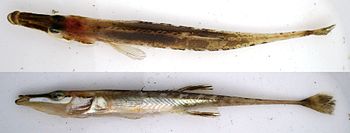Sea stickleback
| Sea stickleback | ||||||||||||
|---|---|---|---|---|---|---|---|---|---|---|---|---|

Sea stickleback ( Spinachia spinachia ), |
||||||||||||
| Systematics | ||||||||||||
|
||||||||||||
| Scientific name of the genus | ||||||||||||
| Spinachia | ||||||||||||
| Cuvier , 1816 | ||||||||||||
| Scientific name of the species | ||||||||||||
| Spinachia spinachia | ||||||||||||
| ( Linnaeus , 1758) |
The Stickleback ( Spinachia spinachia ) is occurring exclusively in saltwater representatives of sticklebacks .
The genus Spinachia is monotypical, that is, the stickleback is the only species represented. Originally still assigned to the genus Gasterosteus by Linnaeus , the stickleback was later raised by Cuvier to the rank of its own genus.
distribution and habitat
The sea stickleback inhabits the European coastal areas from the North Cape to the Bay of Biscay. It occurs only sporadically in the Baltic Sea east of Bornholm and in the Wadden Sea of the North Sea.
Preferred habitats are seaweed and seaweed regions down to a depth of about ten meters.
features
Within the family Gasterosteidae the stickleback is the largest species, it reaches a standard length of 14 to 20 centimeters. Females are usually larger than their male counterparts. The body is remarkably thin and elongated. Five edges run across the middle of the back, the sides and on the sides of the stomach and create a pentagonal cross-section. The elongated shape is emphasized by a long tail stalk and an equally long head with an almost tubular snout. The length of the snout is almost two and a half times the diameter of the eye. The mouth is very small and slightly above. The sides of the body are each covered with a series of around 40 to 42 very small bone shields. The tail stalk is fully armored and therefore relatively stiff. In front of the soft-rayed dorsal fin , the stickleback has 14 to 17 (mostly 15) small foldable spines. Sometimes the successive spines are arranged alternately to the right and left. The belly spines are also very short. The dorsal and anal fin are approximately triangular in shape. As is typical for families, the coloration is quite variable; it is also influenced by the habitat. In the vegetation-rich environment, an olive to brownish basic color prevails, with a darker back and a lighter, sometimes almost silver belly. A yellow-brown basic color is predominant in areas with few plants. The sides have a broad brownish band along the side line that begins at the muzzle, runs horizontally through the eye and extends to the base of the caudal fin . The slightly raised middle parts of the side shields stand out in front of it as a light stripe. Adult males appear slightly lighter than females due to light spots in the longitudinal band, but in contrast to the three-spined stickleback ( Gasterosteus aculetus ) and the nine-spined stickleback ( Pungitius pungitius ), they do not wear a distinctive wedding costume.
Fins formula : dorsal 1 XV (XIII – XVII), dorsal 2 6–7, anal I / 6–7, caudal 13, pectoral 10 , ventral I / 1–2
Behavior and way of life
The adult, mostly solitary, sea stickleback feeds on small benthic crabs and other invertebrates. Zooplankton only plays a role in the nutrition of juvenile fish, as adult animals usually avoid the open water. During the spawning season, which lasts from May to June, it fixes its spherical nest, about five to eight centimeters in diameter, between algae at a depth of 50 centimeters to a maximum of 1 meter below the water surface. Although breeding areas are preferred that have a sufficient water level even during low tide , the clutches can withstand temporary drying out. The father animals return to their nests when the water rises. The offspring are very fast-growing and can reproduce in the following spring. The reproductive behavior of the stickleback is more archaic than that of its relatives from the genera Gasterosteus and Pungitius . The nest is of a simpler structure and does not undergo any further modifications during the brood, as can be observed in other stickleback species. The courtship is also less complex and is apparently made more difficult by the lack of a wedding dress for both sexes, as potential mating partners are more difficult to recognize. Males guarding their breeding area initially attack all approaching conspecifics, but females willing to spawn then remain passive and are likely to be recognized as potential partners. The approach to the nest takes place quickly and without complex rituals. Once there, the male animal points with his snout at the entrance. If the female is then in the nest, the male triggers the egg-laying by biting into the protruding tail stalk. These bites are significantly reduced in the other stickleback species and are only carried out as harmless nudges.
Compared to other stickleback species, the sea stickleback has been less well researched, partly because it is much more difficult to reproduce in the aquarium. The species is likely to be quite short-lived and is said to be two years old.
literature
- Hans-Joachim Paepke: The sticklebacks. Gasterosteidae. 2., revised. and additional edition. Westarp Sciences, Magdeburg 1996, ISBN 3-89432-492-9 . P. 33ff.
- Horst Müller: Fish of Europe. Neumann Verlag, Leipzig - Radebeul 1983, ISBN 3-7402-0044-8 . P. 285ff.
Web links
- Sea stickleback on Fishbase.org (English)
